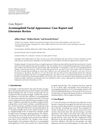Search
forLearn
2 / 2 resultslearn Osteopontin
signaling protein that, when suppressed, may grow hair by reducing inflammation and stem cell loss
Research
5 / 1000+ results
research Acromegaloid Facial Appearance: Case Report and Literature Review
The document concludes that AFA should be considered in patients with acromegaly-like features but normal hormone levels, and more cases need to be identified to understand the condition fully.
research Familial 1q22 Microduplication Associated With Psychiatric Disorders, Intellectual Disability, and Late-Onset Autoimmune Inflammatory Response
A specific genetic change is linked to mental disorders, intellectual disability, and possibly autoimmune disease in a family.
research Isochromosome Mosaic Turner Syndrome: A Case Report
A 20-year-old woman with a rare form of Turner syndrome showed improvement with hormonal therapy and needs comprehensive care.

research Recurrent Pregnancy Loss Associated with Cytogenetic and Genetic Anomalies: A Study from Eastern India
Genetic variations contribute to over 10% of recurrent early pregnancy loss cases.

research A PAX1 Enhancer Locus Is Associated With Susceptibility to Idiopathic Scoliosis in Females
A genetic region near the PAX1 gene is linked to a higher risk of scoliosis in females.
Community Join
5 / 43 resultscommunity Evidenced Based Meta-Analyses and Systemic Reviews of Androgenic Alopecia and Treatments
Evidence-based treatments for androgenic alopecia, such as minoxidil, finasteride, low-level laser light therapy, dutasteride, platelet-rich plasma, and topical ketoconazole. It discusses the efficacy, safety, and mechanism of action of these treatments, as well as future developments in understanding this polygenic condition.
community 30-Min Dermatology Visit – Best Questions to Ask About Balding? ( 175$ )
The conversation discusses hair loss treatments, focusing on finasteride, minoxidil, and other options like PRP and ketoconazole. It highlights the importance of asking specific questions during a dermatology visit to determine the cause of hair loss and appropriate treatments.
community IVF process on Finasteride and effects of stopping finasteride.
Concerns about finasteride affecting sperm quality and embryo abnormalities during IVF. The user plans to stop finasteride for 6 months and use minoxidil, microneedling, a red light cap, and saw palmetto shampoo to manage hair loss.
community Female, 30, PCOS diagnosis, MPB Norwood 2. Endo refuses to give anything other than Spironolactone. Feel like I’m at my wit’s end here.
A 30-year-old female with PCOS and male pattern baldness is frustrated with her endocrinologist's recommendation of only Spironolactone and minoxidil, feeling that dutasteride, finasteride, and progesterone would be more effective. Other users suggest various online sources for treatments, warn against self-medicating due to potential risks, and recommend seeking a specialized endocrinologist or considering additional treatments like Inositol, Berberine, and dermaneedling.
community Hair loss and ethnicity - Caucasian men the most likely to experience hair loss
The conversation discusses how Caucasian men are more likely to experience hair loss due to genetic predisposition, with factors like the androgen receptor on the X chromosome playing a significant role. The user also expresses confusion about the evolutionary reasons for hair loss, especially in colder climates where it would seem beneficial to retain hair for warmth.